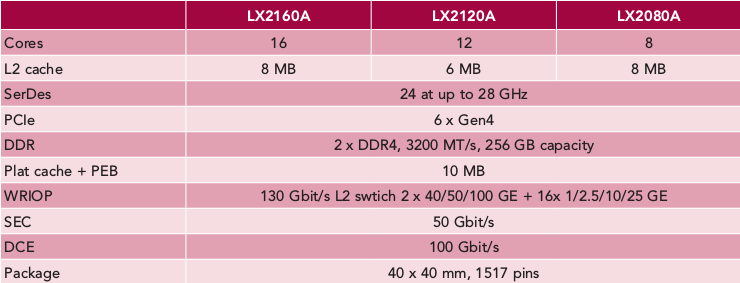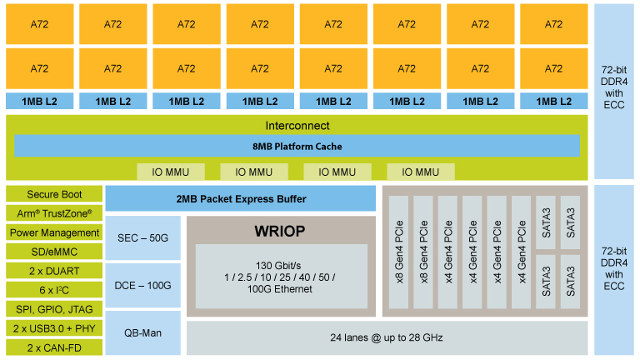- Processor – 16x Arm Cortex-A72 CPU cores, running up to 2.2GHz with 8MB L2 cache, 8MB platform cache
- Memory I/F – 2 x DDR4 72b including ECC, up to 3200 MT/s,
maximum capacity of 256 GB
- Storage – 4 x SATA3.0
- Ethernet
- Up to 16 Ethernet ports
- Supported Ethernet speeds include 1, 2.5, 10, 25, 40, 50, and 100 gigabits per second
- 130Gbps Layer 2 Ethernet switch
- PCIe – Up to 24 PCIe Gen4 lanes, supporting ports as wide as x8
- 24 SerDes lanes, operating up to 28GHz
- Acceleration Engines – 50Gbps security accelerator, 100Gbps data compression/decompression engine
- Security – Secure boot and Arm TrustZone technology
- Peripherals – SD, eMMC, 2 x DUART, 6 x I2C, 2 x USB3.0, 2 x CAN
(FD optional)
- Package – 40×40 mm, 1517 pins
- Process – 16nm FinFET
- TDP – 30 Watts
LX2160A will be supported in the Linux SDK for QorIQ processors, and be compatible with CodeWarrior Development Software for ARMv8 64-bit based QorIQ Series Processors.

NXP will also provide versions with 12 cores (LX2120A) and 8 cores (LX2080A). None of those will be found in your home router / NAS, with typical applications including network function virtualization (NFV), white box switching (e.g. control plane for L2 switches in TOR and EOR applications), enterprise storage controller, and 5G packet processing.
Sampling was planned in Q1 2018, and mass product is expected sometimes in 2019. Pricing is not available yet, but the Linley Group expects LX2160A processor to sell for about $350 per unit for 1k orders. Visit the product page for a few more details.








I like the way they combined the PCI-E and Ethernet controllers behind generic SerDes blocks. I’ve seen that done in FPGAs, but I don’t have any experience with seeing it in an application processor like this. Does anyone know if this is a common thing?
Nice looking chip.
It is, if you work with Freescale/NXP or Marvell.
Indeed, Marvell ARMADA series does the same, only there the serdes lanes are fewer.
BTW, really curious to see the TDP of that SoC.
A 40x40mm chip is large enough to receive a huge heatsink and fan 🙂 I’d bet something in the 35W range. But it looks very appealing for network applications! I’d like to try a board with it!
35W was a good guess — I’ve missed the TDP listed at the bottom of the specs, and that reads 30W : )
What is more interesting is that this must be the first 16nm (TSMC) part by Freescale, to my knowledge.
BTW, another curious fact is that just like Marvell ARMADA’s 8K series, cores come in dual-core clusters, and scaled-down versions disable either clusters or halve cluster configs.
Does anyone know what the working temperature range of LX2160A is? Thx.